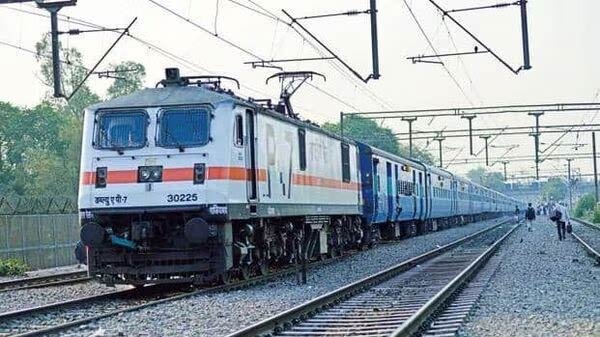Enhanced financial prospects are on the horizon for Indian Railways in FY25, with projected revenue growth and increased governmental assistance expected to bolster the organization’s performance.
Indian Railways Forecasts Improved Financial Performance
Two informed sources have disclosed that Indian Railways is anticipated to witness a stronger financial performance in the coming year, buoyed by augmented revenues and increased financial support.
According to the sources, the upcoming Union budget is likely to set Indian Railways’ operating ratio for FY25 at a level below 98%, marking the first time in four years that such a projection has been made. It’s important to note that an operating ratio of 98% signifies that the Railways need to expend ₹98 to earn ₹100. A reduction in the operating ratio translates to a surplus for capital expenses, while an increase denotes the opposite.
Despite facing an increment in its operating ratio during FY22, FY23, and FY24 (as per budget estimates), following a decline to 97.45% in FY21, Indian Railways aims to reverse this trend in FY25. The railway’s substantial pension liabilities were a significant contributor to the elevated operating ratio in recent years.
The recovery of the railways’ operations post-COVID-19, coupled with a resurgence in both freight and passenger revenues, is poised to provide the necessary impetus for the national transporter to bolster its internal revenue generation in FY25, thereby diminishing the operating ratio. Additionally, expectations are rife that the gross budgetary support will continue to surpass 90% of the total allocation, thereby facilitating a reduction in the operating ratio, as per one of the individuals mentioned earlier.
Despite reaching out to the railway ministry for comments, no response has been received at the time of publication.
Looking ahead, Indian Railways aspires to become self-sufficient in funding its own expenses. During a prior interview, Railway Minister Ashwini Vaishnaw outlined that the railway’s pension expenditure of ₹51,000 crore, combined with salary and wage costs of ₹1 trillion, energy costs of ₹40,000 crore, and maintenance and spare costs of ₹8,000 crore are currently being met through internal revenue. Furthermore, with the anticipated alleviation of major impediments in freight movement by March 2024, the railways are poised to witness a surge in cargo traffic, underscoring a positive outlook for the future.
Indian Railways Eyes Improving Financial Performance in Line with Projections
Amidst a backdrop of subdued mobility and contracted revenues due to the pandemic, Indian Railways is poised for a resurgence in the upcoming fiscal year, potentially surpassing previous records for freight and passenger traffic. The renewed optimism is driven by the minister’s positive outlook and expectations of robust growth in traffic revenue for FY25.
Revenue Projections and Growth in Traffic Revenue
In FY24, Indian Railways anticipates its traffic revenue to reach approximately ₹2,64,600 crore, reflecting a 9% increase from the previous year. The revenue composition encompasses 99.8% of the total earnings, with freight services contributing approximately 68% (₹1,79,500 crore) and passenger services contributing around 26% (₹70,000 crore).
Operating Ratio Outlook
The operating ratio target for FY24 stands at approximately 98.45%, with the prospect of further improvement at the revised estimate stage. Bolstered by enhanced revenue and prudent management of subsidies and non-essential expenses, the railways aims to drive the operating ratio down and set the stage for a target of 95% in FY26, with continued positive momentum in subsequent years. The prospect of achieving this marks a significant shift from the challenges faced during the pandemic, with a notable increase in the operating ratio in FY22 and a relatively high ratio in FY23.
Financial Support and Resilience
In light of the pandemic-induced resource gap, Indian Railways received a special central loan of around ₹80,000 crore in FY21, mitigating the impact on its operating ratio during that period. However, the absence of this support in FY22 resulted in a significant deviation from the targeted ratio, standing at 107.39%. The subsequent fiscal year saw a continued burden on the operating ratio, with FY23 registering at 96.98%.
As the railways aims to rebound from the challenges posed by the pandemic, the upcoming Union budget is expected to lay the groundwork for sustained financial resilience and growth. The resurgence in freight and passenger revenues, coupled with renewed operational vigor, positions Indian Railways for a positive trajectory in the upcoming fiscal year and beyond.
The buoyancy in revenue generation and the strategic focus on cost management are integral to the railways’ vision of achieving a lower operating ratio, signaling a pivot towards self-sufficiency in funding operational expenses. The railway budget for FY25 is anticipated to align with these projections and provide the necessary impetus for Indian Railways to propel its financial performance to new heights.
Indian Railways’ Anticipated Financial Fortunes in FY25
The anticipation of improved financial performance in FY25 for Indian Railways comes on the heels of heightened revenues and increased financial assistance. Despite a high operating ratio in FY24, largely due to substantial pension provisioning of approximately ₹70,000 crore, there is hope that this provisioning will alleviate some of the financial burdens in the upcoming fiscal year.
Crucial Financial Support and Projections
The railway’s gross budgetary capital expenditure (capex) support is anticipated to surge by over 25% to reach around ₹3 trillion in the next fiscal year. Simultaneously, an ambitious goal to increase freight earnings to 4.5-5 million tonnes per day from the current 4 million tonnes per day is envisaged, with a target to earn over ₹2 trillion.
Recovery and Improved Operating Ratio
The railway sector is banking on the resumption of normalcy in travel and a projected growth in passenger revenues to contribute to a reduction in the operating ratio for FY25. In the wake of COVID-19, passenger train services were halted in FY21 to mitigate the pandemic’s spread, leading to a 16% decline in revenue from freight traffic and a substantial 75% drop in passenger traffic revenue compared to budget estimates.
Positive Performance and Future Strategies
Despite the challenges, in FY22, freight earnings saw a 5% increase over budget estimates, while passenger revenue experienced a 27% decrease. Notably, the operating ratio improved to 97% in FY21 from 98.4% in the previous year, primarily attributed to growth in freight earnings and additional central fund support. Furthermore, the reduction of costs and the cessation of several subsidized rail services also played a pivotal role in boosting performance.
Strategic Measures and Fiscal Prudence
Looking ahead to FY25, the railway budget is expected to prioritize augmenting resources while reigning in non-essential expenditure. Notable initiatives include the ambitious target of completing 100% electrification of the broad-gauge line by FY24, potentially resulting in an annual reduction of nearly ₹10,000 crore in the railways’ fuel expenses. Additionally, a focus on expanding non-fare revenue sources is anticipated, with a particular emphasis on increased asset monetization, including the dedicated freight corridor and the sale and commercialization of railway land at key destinations.
In conclusion, the expected financial trajectory for Indian Railways in FY25 hinges on various strategic and financial measures aimed at bolstering revenue, curbing expenses, and enhancing operational efficiency.











